As we reel from another incomprehensible tragedy, we must ask: how many more lives need to be sacrificed before we decide that enough is enough?
By Ryan McGreal
Published December 08, 2020
Last Tuesday, December 1, eleven-year-old Jude Strickland was walking home from Templemead School with his siblings and friends.
They walked west on Royalvista Drive to the intersection of Royalvista and Upper Gage Avenue, a busy arterial dividing the Templemead and Eleanor neighbourhood blocks. The intersection is signalized with zebra crosswalks and has a crossing guard on duty.
With a green traffic signal and the crossing guard as chaperone, the children began crossing Upper Gage westbound on the south side of the intersection.
At this very moment, witnesses say, a man driving a Dodge Ram pickup truck was speeding southbound on Upper Gage. He allegedly swerved to pass other vehicles in his way and then sped into the intersection right through the red traffic signal.
The collision happened on the far side of the intersection, where the children were crossing legally with the crossing guard. Jude was rushed to hospital with critical injuries. On Thursday, December 3, his grief-stricken family confirmed that he had died in hospital.
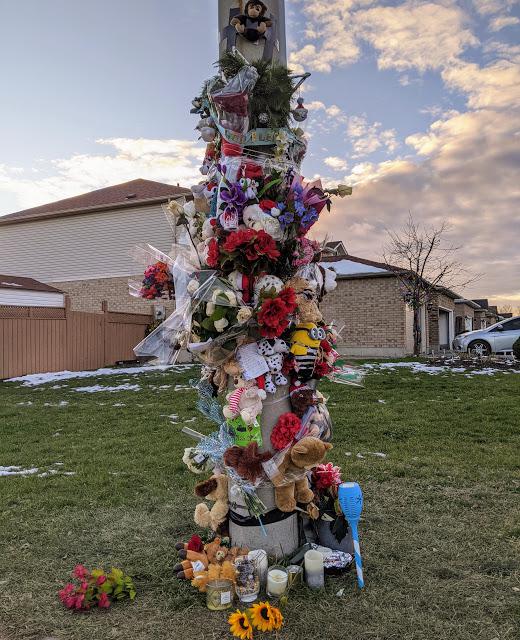
Roadside memorial for Jude Strickland on the southwest corner of Upper Gage and Royalvista
Police allege that the driver, a 28-year-old man, failed to stop for the red traffic signal and failed to stop for the crossing guard. They originally charged the driver with dangerous operation causing bodily harm, but then revised the charge to dangerous operation causing death.
Would a different street design in the neighbourhood to make the streets inherently more safe have prevented Jude's death? There is no way to know for certain. What we do know is that when streets are designed to make it physically difficult to drive at a dangerously high speeds, there is measurably less speeding, lower top speeds, fewer serious collisions, fewer injuries, and fewer deaths.
We know that when vehicle speeds are reduced on streets used by pedestrians, the number and severity of pedestrian collisions go down and the likelihood of a collision resulting in fatality goes down as well. When vehicle speeds are reduced from 50 km/h to 30 km/h, the fatality rate declines from 45 percent toward zero.
It's a matter of physics and cognitive processing time. At lower speeds, drivers have wider peripheral vision and can see vulnerable road users sooner. At lower speeds, the distance a vehicle travels during the time the driver notices someone on the road is shorter, and the stopping distance is also shorter, so they have more opportunity to avoid a collision.
In addition, the kinetic energy of a moving vehicle is a geometric function of its speed, so a vehicle moving twice as fast has four times the destructive force.
At faster speeds, collisions are both more likely to occur and also more likely to have serious consequences.
The concept of "Vision Zero" started in Sweden in 1990 and is as simple as it is ambitious: its goal is to reduce the number of traffic fatalities to zero. The idea of Vision Zero is that telling people to be more careful is not enough. The street network itself must be redesigned so that predictable human behaviour does not result in tragedy.
We know there will be distracted drivers, impatient drivers, incompetent drivers and reckless drivers. It's not good enough to accept that those drivers will maim and kill people, and then punish them after the fact. We need to ensure that their distraction, impatience, incompetence and recklessness is mitigated beforehand by street designs that prevent them from exposing others to deadly danger.
Cities around the world have adopted a Vision Zero approach to traffic safety with impressive and steadily-improving results.
Helsinki, the capital of Finland, has a population of 650,000 residents. As part of a long-term commitment to making the city safer and more livable, Helsinki adopted a "Vision Zero" plan to eliminate traffic deaths. This wasn't just a feel-good, nice-to-have aspirational statement, it was a concrete, measurable commitment to reduce the actual number of traffic fatalities to zero.
In 2019, Helsinki had zero pedestrian deaths, zero cyclist deaths, and just three motorist deaths.
Helsinki is not alone. Oslo, the capital of Norway, has a population of just under 700,000 residents and has also kept a long-term commitment to make the city safer and more livable.
In 2019, Oslo had zero pedestrian deaths, zero cyclist deaths, and just one motorist death.
Meanwhile, in Hamilton (population 550,000), Jude Strickland is our 14th traffic death so far this year.
Like other cities, our City Council has also officially adopted a Vision Zero statement. But unlike cities that are actually reducing their traffic fatalities to zero, we have not really been committed to following through with the necessary changes that would make our streets safe.
After years of foot-dragging on road safety policy, Council finally agreed to a citywide traffic calming plan this past July. As part of the plan, the City is reducing the default speed limit on local residential streets from 50 km/h to 40 km/h.
This is a bizarre compromise that tries to split the difference between preventing fatalities and maintaining driver entitlement. As we know, a Vision Zero approach to safety requires a speed limit of 30 km/h. By adopting a speed limit of 40 km/h, Council has determined that some traffic fatalities are an acceptable trade-off so that drivers can arrive a minute faster.

Templemead School with flag flying at half-mast
The traffic calming plan also establishes the ability to set 30 km/h zones in a 150-metre radius around schools as designated school zones. This is an absurdly small radius for a safety envelope around schools: 150 metres is a one- to two-minute walk. What about children who live more than two minutes from school?
For some tangible context of just how short 150 metres is, the distance along Royalvista from Templemead Drive in front of the school to Upper Gage is 220 metres - so the 30 km/h School Zone speed limit wouldn't even reach Upper Gage despite the number of children who cross there every day.
Indeed, there are School Zone signs on residential side streets around Templemead School, but no such signs on Upper Gage itself.
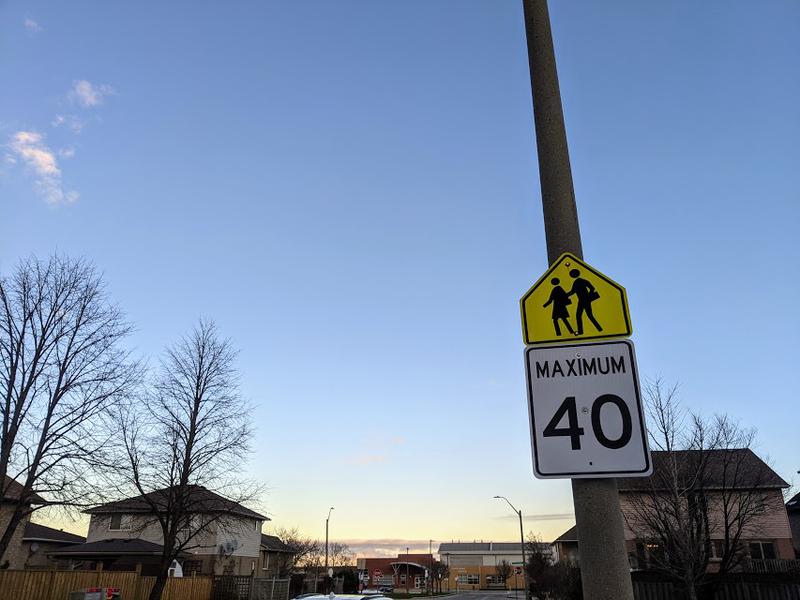
School Zone and 40 km/h speed limit sign on Royalvista Drive
According to the City's designation of streets, Upper Gage is a designated Minor Arterial street. That means it is automatically disqualified from traffic calming consideration under the traffic calming plan's pre-screening process.
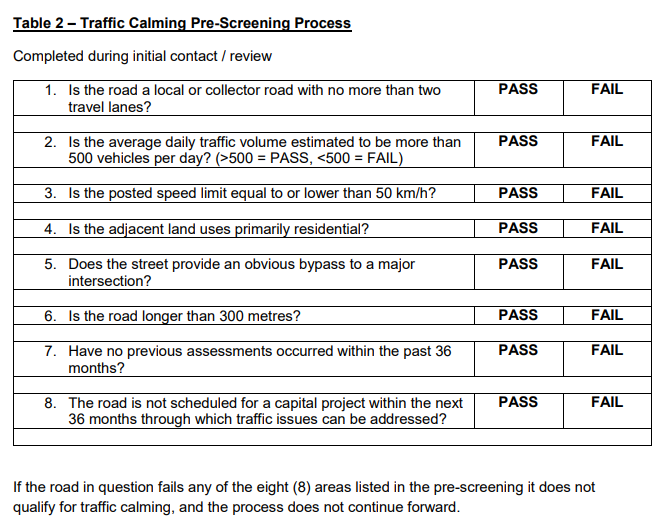
City of Hamilton Traffic Calming Pre-Screening Process (Image Credit: City of Hamilton)
Between Stonechurch and Rymal, Upper Gage has a regular traffic volume of around 14,000 vehicle trips a day. It has a 50 km/h speed limit, and a large fraction of students commuting on foot to Templemead School have to cross it twice a day.
Here are the facts on the ground: It is not merely physically easy to drive across a daily walking path for elementary school students at speeds high enough to make deadly collisions a serious risk. It is not even merely legal to drive at such speeds. The City's own traffic calming policy actually disqualifies this street from calming because it's considered too busy.
Can we please agree that it is objectively insane to have a traffic calming policy that prohibits traffic calming on the very streets that need it the most?
On Monday, I had the opportunity to walk along Upper Gage and around Templemead with Timothy Taylor and Tiffany Bound-Koocher, a couple who live in the community and whose children attend Templemead School. Timothy and Tiffany are devastated by this tragedy and are determined to do something about it.
They're frustrated with the lack of urgency before now to put safety measures in place in their community, and they've clearly given a lot of thought to what is needed.
They want flashing School Zone signs on Upper Gage and a reduced speed limit. They want a crossing guard at the crosswalk on Templemead Drive and Arno Street, just north of the school. They want curbside parking pushed back from intersections to improve visibility. They don't understand why the 40 km/h zone on Royalvista reverts to 50 km/h through the intersection across Upper Gage.
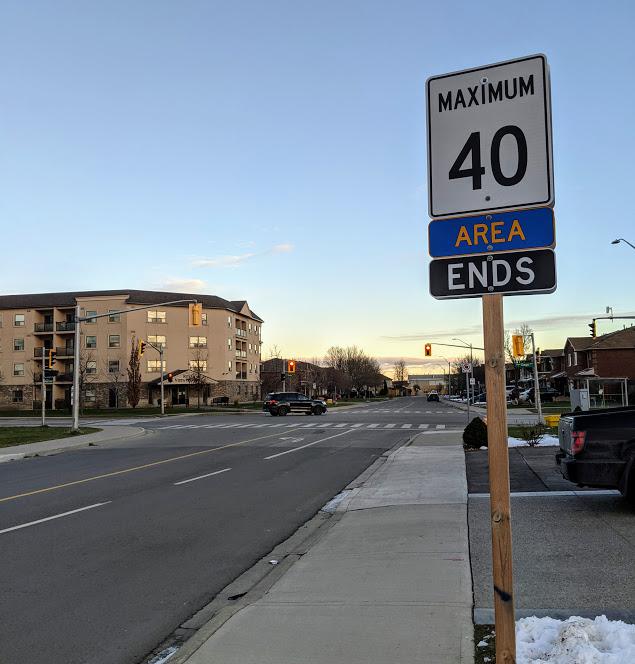
40 km/h speed limit ends on Royalvista before Upper Gage
They drafted a petition calling for immediate safety improvements on Upper Gage and the surrounding streets. You can download a copy of the petition here to fill out and return to Timothy and Tiffany (their contacts are on the second page):
The couple have been concerned about traffic safety for years. Timothy actually ran for Ward 6 in the 2018 municipal election on a safe streets campaign. He lost to incumbent Councillor Tom Jackson, who has represented the ward since 1988.
In an email response to RTH, Councillor Jackson expressed dismay at the tragedy. "I am absolutely heartbroken and livid at the tragic loss of little Jude Strickland's innocent life!"
Noting that the intersection is fully signalized with ladder crosswalks and a crossing guard and that Upper Gage is just three lanes wide here, compared to five lanes wide farther north, he added, "As the mourning continues for the Strickland Family, community efforts are already in place mobilizing for additional traffic safety enhancements," citing the petition drive.
Jackson also committed to a motion that "directs City staff to encompass and explore every possible further tool that may be feasible for making both that intersection and that section of Upper Gage safer too." At the Public Works Committee meeting on Monday, Jackson brought forward a motion to this effect that passed unanimously:
That Transportation Operations and Maintenance staff undertake a roadway safety audit based on Vision Zero principles of Upper Gage Avenue, between Stone Church Road East and Rymal Road East, to assess potential safety enhancements such as a reduced speed limit, school zone flashing lights, physical changes to the lane configuration, and the feasibility as a future location for an automated speed enforcement camera or red light camera.
The motion still needs to be ratified by the full Council. Assuming it passes, this is a welcome response, but the larger question remains: why is our new traffic calming policy so unambitious that the Councillor needs to direct staff to manually override the policy in order to achieve traffic calming?
Jackson has asked staff to comment on the 40 km/h speed limit, the small radius of school zones and the limitation on traffic calming on arterial streets. RTH will follow up with that response if and when we receive it.
Riding home Monday evening after walking around Templemead with Timothy and Tiffany, I took the Keddy Access Trail down the escarpment, painfully aware of the grim irony. The brand-new protected multi-use path along Claremont Access is named after Jay Keddy, a Hamilton resident and beloved kindergarten teacher at Central School. Jay was killed exactly five years ago, on Wednesday, December 2, 2015 while riding home from work up Claremont - also by a man driving a pickup truck.
For years, safe streets advocates had been highlighting the need for a physically protected escarpment access route, which was identified as a priority in the 2009 Cycling Master Plan. It wasn't until after Keddy was killed riding home from school that Council started to take their own plan seriously. Even so, it took another five years, plus provincial funding, to get it done.
This is a morbid recurring theme in safe streets advocacy for Hamilton: again and again, we ignore clearly identified risks and fail to take action until after someone is killed and public outrage becomes impossible for Council to keep ignoring.
A designated crosswalk on the Escarpment Rail Trail across Wentworth Avenue South didn't become a reality until several years after Zoe Nudell was killed by an impaired driver when she was jogging on October 30, 2013. Safe streets advocates had been asking for years for a safe crossing there, to no avail.
Today, as we continue to reel from another incomprehensible tragedy, we must ask: how many more lives need to be sacrificed before we decide that enough is enough?
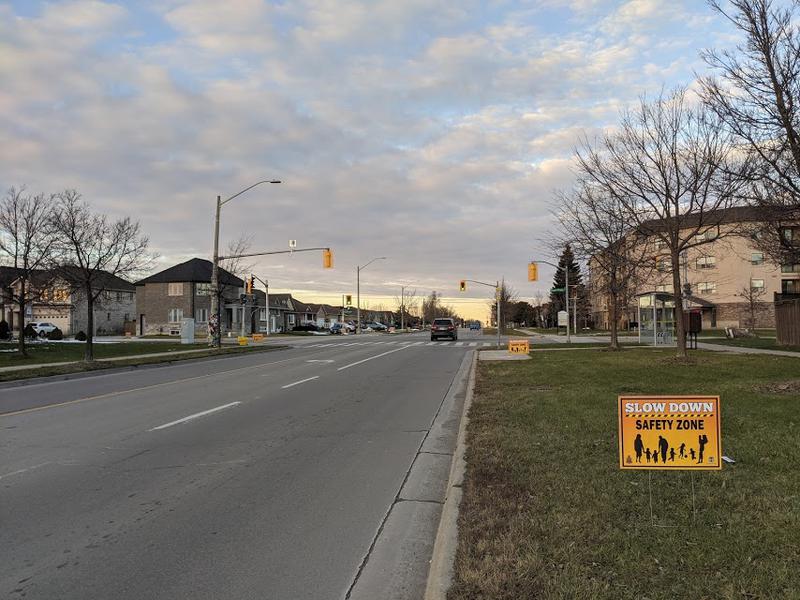
'Slow Down' signs posted on Upper Gage after the fatal collision
By ceesvang (registered) | Posted December 09, 2020 at 09:07:29
"As we know, a Vision Zero approach to safety requires a speed limit of 30 km/h. By adopting a speed limit of 40 km/h, Council has determined that some traffic fatalities are an acceptable trade-off so that drivers can arrive a minute faster." Any councilor proposing a city wide and ENFORCED 30km/h will not survive an election and thus we are stuck with a see no evil, hear no evil and do absolutely nothing to correct the horrific traffic policies of our city council.
By AP (registered) | Posted December 09, 2020 at 13:57:19 in reply to Comment 130677
The call isn't for ALL streets to be 30km/h, but I understand what you are saying, and it screams of the importance of term limits. An elected representative should be focused on what's best for the community, not what's most likely to get them re-elected. Reminds me of this piece (particularly part 2) from The Daily Show many years back: https://youtu.be/A0FLsIzNxkI
By Ryan (registered) | Posted December 09, 2020 at 14:26:27 in reply to Comment 130678
Here's a comparison map of Helsinki that is colour-coded by street speed limits at different times:

As the number of streets with a 30 km/h limit has gone up, the number of pedestrian fatalities has gone down.
By Normanhurst1 (registered) | Posted December 24, 2020 at 16:29:43
Reducing speed limits is an over simplistic idea to this problem. Not going outside would reduce fatalities to zero but that's not going to happen either. The problem is too many drivers have so little respect for anyone else, a sense of entitlement and also no fear of breaking the law due to lack of police enforcement. The attitude of the driver needs to change, not the design of the roads or speed limits. Apathy and narcissistic attitudes are the problem.
By Ryan (registered) | Posted December 28, 2020 at 07:47:16 in reply to Comment 130682
With respect, thinking you can address this problem by telling drivers to behave differently is the over-simplistic idea that we have been trying, and failing, to do for decades. In contrast, places that actually transform their street designs to be inherently safer are the places that actually prevent traffic deaths.
You must be logged in to comment.
There are no upcoming events right now.
Why not post one?